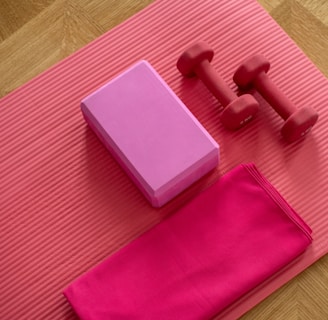Beginner’s Guide to Strength Training at Home
HEALTH & FITNESS
2/7/20253 min read


Beginner’s Guide to Strength Training at Home
Strength training is one of the most effective ways to improve your overall fitness, build muscle, boost metabolism, and enhance your strength. The great news? You don’t need a gym to get started! With just your body weight or a few simple pieces of equipment, you can begin your strength training journey from the comfort of your home.
This guide will walk you through everything you need to know as a beginner—from benefits to exercises and workout plans.
Why Strength Training at Home?
Strength training at home offers several benefits:
Convenience – No commute to the gym means more time saved.
Cost-effective – No expensive gym memberships or fancy equipment required.
Privacy – Work out comfortably at your own pace without feeling self-conscious.
Flexibility – Exercise whenever it fits your schedule.
Customizable – Tailor workouts to your goals and fitness level.
Now, let’s dive into the essentials of getting started.
What You Need to Get Started
While bodyweight exercises are effective, a few affordable pieces of equipment can enhance your strength training experience:
Yoga Mat – Provides comfort and stability.
Resistance Bands – Great for adding resistance without heavy weights.
Dumbbells or Kettlebells – Ideal for progressive overload.
Stability Ball – Useful for core and balance exercises.
Pull-up Bar – Adds variety for upper-body workouts.
Basic Strength Training Principles for Beginners
To see progress, follow these key principles:
1. Start with Bodyweight Movements
Before adding resistance, master bodyweight exercises to build foundational strength.
2. Focus on Proper Form
Good technique reduces injury risk and maximizes effectiveness. Quality over quantity!
3. Progressive Overload
Gradually increase intensity by adding weight, reps, or resistance over time.
4. Allow Recovery Time
Your muscles grow during rest. Aim for at least one rest day between strength training sessions for the same muscle group.
5. Consistency is Key
Stick to a structured routine for long-term progress.
Essential Beginner-Friendly Strength Training Exercises
Upper Body Exercises
1. Push-Ups
Muscles Worked: Chest, shoulders, triceps, core
How to Do It: Start in a high plank position, lower yourself until your chest nearly touches the ground, and push back up.
Modification: Do knee push-ups if needed.
2. Dumbbell Shoulder Press
Muscles Worked: Shoulders, triceps
How to Do It: Hold dumbbells at shoulder height and press them overhead.
3. Bent-Over Rows
Muscles Worked: Back, biceps
How to Do It: Hinge forward at the hips, hold dumbbells, and pull them towards your chest.
Lower Body Exercises
4. Squats
Muscles Worked: Quads, hamstrings, glutes
How to Do It: Stand with feet shoulder-width apart, lower your hips down and back, then push up through your heels.
5. Lunges
Muscles Worked: Legs, glutes
How to Do It: Step forward into a lunge position, keeping your back straight. Alternate legs.
6. Glute Bridges
Muscles Worked: Glutes, hamstrings, core
How to Do It: Lie on your back with knees bent, lift your hips, and squeeze your glutes.
Core Exercises
7. Planks
Muscles Worked: Core, shoulders, glutes
How to Do It: Hold a plank position with your body in a straight line.
8. Russian Twists
Muscles Worked: Obliques, core
How to Do It: Sit with your legs elevated and twist your torso side to side.
Beginner Strength Training Routine (No Equipment)
Perform this circuit 3 times per session, resting 30–45 seconds between exercises:
Bodyweight Squats – 15 reps
Push-Ups – 10 reps
Glute Bridges – 15 reps
Bent-Over Rows (if using resistance bands or weights) – 12 reps
Plank – Hold for 30 seconds
Repeat 3–4 times per week, increasing reps and difficulty over time.
Tips for Staying Motivated
Set Realistic Goals – Start small and progress gradually.
Track Your Progress – Keep a journal or use an app.
Mix It Up – Vary your workouts to stay engaged.
Find a Workout Buddy – Adds accountability and fun.
Celebrate Small Wins – Every step counts toward your fitness journey!
Common Mistakes to Avoid
Skipping Warm-Ups & Cool-Downs – Increases injury risk.
Lifting Too Heavy Too Soon – Can lead to strain or injury.
Poor Form – Reduces effectiveness and can cause pain.
Not Resting Enough – Muscles need time to recover and grow.
Frequently Asked Questions
1. Can I build muscle without lifting weights?
Yes! Bodyweight exercises like push-ups and squats build strength, and you can add resistance with bands or household items.
2. How often should I do strength training?
Aim for at least 2–3 sessions per week, with rest days in between.
3. Can strength training help with weight loss?
Yes! Strength training boosts metabolism, helping you burn more calories even at rest.
4. When will I see results?
With consistency, you may start noticing strength gains in 4–6 weeks.
Final Thoughts
Strength training at home is a fantastic way to build muscle, improve overall fitness, and boost your confidence. With just a little space and dedication, you can achieve impressive results. Start with the basics, progress gradually, and enjoy the journey to a stronger you!
Disclaimer: This article is for informational purposes only and should not be considered medical advice. Always consult a healthcare professional before beginning any new exercise program, especially if you have any pre-existing medical conditions or injuries.
